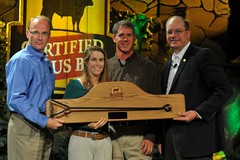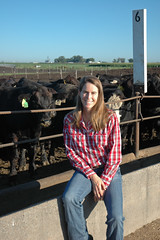 Life is full of transitions and changes—how else would a city girl get from South Florida to New Hampshire to a cattle farm in Central Nebraska? It will *hopefully* be less of a culture shock for this “feedyard foodie” to enter the world of social media than it was to move to Nebraska and learn to care for cattle! That being said, please be advised that I am much more comfortable handling cattle and riding my horse than I am posting blogs and figuring out what a “widget” is!
Life is full of transitions and changes—how else would a city girl get from South Florida to New Hampshire to a cattle farm in Central Nebraska? It will *hopefully* be less of a culture shock for this “feedyard foodie” to enter the world of social media than it was to move to Nebraska and learn to care for cattle! That being said, please be advised that I am much more comfortable handling cattle and riding my horse than I am posting blogs and figuring out what a “widget” is!
When I moved from New Hampshire to Cozad, Nebraska I really had no idea what my life was going to look like on a day to day basis. I had always loved animals, had always wanted to spend my time outdoors, and had always been enamored by the romantic notion of a cowgirl. However, I had no “hands on” knowledge of what it took to care for animals. The last fourteen years have been an incredible journey for me. An inexperienced, but well educated urban woman metamorphed into a mature and saavy animal caregiver.
I am so proud of what I do. I believe that humanely raising animals for the production of food is an admirable vocation, and I am committed to both continually improving the welfare of my animals and the safety and quality of the beef that they produce.
I am an American, I am a wife, I am a mother, and I am a cattle farmer. I wear many hats and I wear them with pride. I care for animals that will be harvested to feed to my family and to your family. I take a tremendous personal responsibility for the animals that I raise and I look forward to sharing that journey with you. Please feel free to ask questions—any question that is asked in a respectful manner will get answered.
This is a journey that we will navigate together, as we strive to close the gap that exists between rural America where food is raised, and urban America where food is consumed.










Love, Love, Love your blog! I am a first generation farm wife and recently started a blog. It is so important to tell our story instead of letting others do it for us! Great blog!
The euphemism “harvest” is telling. With all due respect, CAFO owners don’t “harvest.” They consign animals to mass transport animals and factory-like killing floors for brutal deaths.
As you know, increasing numbers of consumers are unwilling to participate in a food cycle that includes subsidized grain, environmental pollution, CAFOs, terrifying transport of animals and inhumane mass slaughter.
More and more of us are willing to pay higher prices to small farmers who care humanely for their animals–including respecting cattle’s natural need to graze and limiting transport to local slaughter houses where the animals’ lives and deaths are honored. See Food Curated hugely popular video: http://foodcurated.com/2011/04/cade-part-2-the-good-slaughter-a-proud-meat-cutter-shares-his-processing-floor/
Lorraine-
I am glad that you visited my site. I hope that you will continue to follow the site so that you can learn more about what I do to care for my animals. I do truly care for my animals, and although I am classified as a CAFO I provide good care to them 365 days out of the year. I believe that I have a personal responsibility to provide quality care to my animals and to work my hardest to grow safe and wholesome beef for all Americans to enjoy.
We do a lot of things at my farm to ensure that our animals maintain mental, emotional, and physical fitness. If you take a minute to watch the video on the home page I talk about this process. I do many things to allow my animals to live and thrive in a low-stress environment. Hopefully you took the time to read all of the posts that I have made so far that have also talked about this. I will continue to blog more in depth about the things that I do everyday to ensure that my animals are healthy and comfortable. I promise you that healthy and comfortable cattle are a priority to me.
You are correct, my animals do go to “harvest” when they leave my farm. They are raised to be harvested for beef much like the animals that you mentioned are. Yes, they must be transported to harvest but we work hard to ensure that their last experience is not one filled with fear. I locally harvest some of my animals, and send some of my animals to a larger processor. I believe that both types of processing facilities do a good job ensuring that fear and pain are minimal for the animals. The facilities where I harvest my animals have audited systems in place to ensure that good animal care is continued all of the way through the harvesting process. I looked at the link that you sent, and am thankful for your additional information.
Again, I appreciate your visit to my blog and hope that you will continue to follow it so that you can discover more about what I do to care for my animals. Please take the time to learn more about me before you judge me. I look forward to us both learning from each other.
All the best,
Anne
Well done, I hope many others will follow your blog and learn more about the good that animal agriculture brings to us all. Thanks.
Anne, So excited to see that you got the blog started! I am excited to read all your posts and stay connected with you! Best of luck!
Glad to have another voice out here for agriculture. LOVE that you are putting up so many photos and some video of your feedyard cause I’ve never been to one!
Blog well done (medium rare on the steak). Look forward to following your work. I work for a company in an allied industry and enjoy finding blogs like yours to share on Facebook and other venues.
Great Blog Anne!! Keep up the good work teaching our consumers what we do to produce the cheapest and safest food supply in the world!!!!
Thanks for the blog, looks great!
I really enjoy your blog. That fact that you are a fellow Nebraskan makes it even better! Thanks for spreading the word on the quality care provided to our livestock in this great state.
From the Panhandle
Society has accepteddieting forces the brain to eat itselfas a form of personal acupressure called
the Emotional Freedom Technique or tapping. These differences must be understood because selecting the wrong diet can
make the dieting forces the brain to eat itself process for your children.
After 2 to 3 months, you might want to be. The chart below shows the rate at which their bodies burn calories.